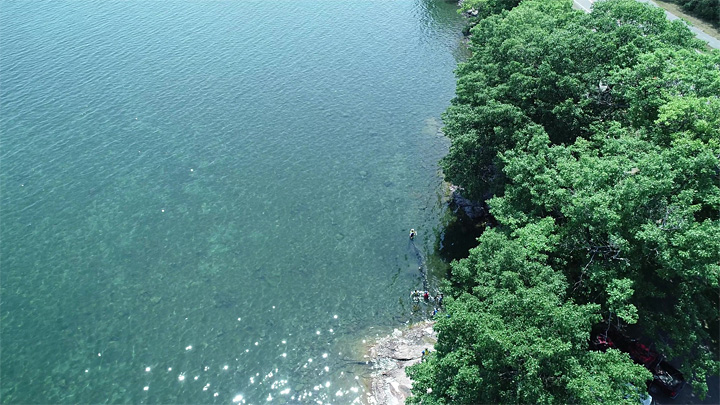Ontario Awards Funding to Further Support the St. Lawrence River Ecosystem
July 18, 2023Cornwall Ontario – The River Institute and Raisin Region Conservation Authority will be receiving over $540,000 from the Ontario government to continue work to monitor the St. Lawrence River ecosystem.

The funding is part of a $6 million investment to support 30 multi-year projects to help protect, conserve and restore the Great Lakes. These investments will help reduce plastic litter, excess nutrients and road salt entering lakes, rivers and streams, advance climate resiliency, and make significant progress on restoring environmentally degraded areas of the Great Lakes.
“Our government is continuing to work with partners to ensure Ontario’s Great Lakes are protected,” said David Piccini, Minister of the Environment, Conservation and Parks. “We’re very proud to be supporting projects that will improve water quality, reduce plastic and salt pollution and increase collaboration with farmers, Indigenous organizations and communities to help improve the Great Lakes.”
Locally, the funding will support the following projects:
- St. Lawrence River Institute of Environmental Sciences, which received $402,187 for projects that will continue monitoring mercury in fish, sediment and industrial sites to make sure clean-up actions in the St. Lawrence River Area of Concern were effective and support the Mohawk Council of Akwesasne to study the health of Lake Sturgeon and Eel.
- Raisin Region Conservation Authority, which received $140,000 to develop and implement an agricultural land stewardship program and facilitate an outreach and education program to improve water quality within the St. Lawrence River Area of Concern.
“Funding from the Ministry of the Environment, Conservation and Parks will ensure continued progress towards restoring the St. Lawrence River Area of Concern by assessing and implementing strategies to minimize exposure to legacy contaminants, particularly mercury in fish and sediments,” says Georgia Bock, Remedial Action Plan Coordinator for the St. Lawrence River Area of Concern. “MECP funding is also helping us build and strengthen inclusive partnerships for a more sustainable and resilient future through its support for the St. Lawrence River Strategy.”
The projects are led by community groups, not-for profits, conservation authorities, universities and Indigenous organizations and communities across the province and support commitments in the Canada-Ontario Agreement on Great Lakes Water Quality and Ecosystem Health and Ontario’s Great Lakes Strategy.
“We are pleased to see the Ministry supporting a sustainable St. Lawrence River watershed by investing in the Remedial Action Plan for our region,” said Martin Lang
Chair of the Raisin Region Conservation Authority Board of Directors. “Through this initiative, the Raisin Region Conservation Authority is working with farmers to foster the implementation of agricultural best management practices that benefit both their operations and the health of our watersheds.”
Great Lakes Program funding is also going to Chiefs of Ontario, Anishinabek Nation and Métis Nation of Ontario as well as 11 First Nations and Métis communities which will lead projects to support commitments in the latest Canada-Ontario Agreement on Great Lakes Water Quality and Ecosystem Health and Ontario’s Great Lakes Strategy.
“The funding and support from the Ministry of the Environment, Conservation and Parks will provide an opportunity to include Indigenous perspectives and cultural dimensions in the Remedial Action Plan process,” said Britney Bourdages, Remedial Action Plan Coordinator at the Mohawk Council of Akwesasne for the St. Lawrence River (Cornwall/Akwesasne) Area of Concern. “The inclusion of cultural dimensions provides additional opportunity to expand the reach of the assessment and management of our shared Area of Concern at Cornwall and Akwesasne. This opportunity will allow for a more in-depth and holistic approach to caring for the St. Lawrence River and reaching our shared goals to have a beautiful and healthy river that can be enjoyed by future generations.”
Funding for the Great Lakes Program is part of the Ontario government’s $14 million in annual investments to further protect, conserve and restore the health of the Great Lakes and support the well-being of communities that rely on them.
Quick Facts
- Ontario’s Great Lakes and St. Lawrence River shoreline is the longest freshwater coastline in the world measuring 10,000 kilometres, which is greater than the length of the Canada-U.S. border and almost equivalent to travelling one quarter of the way around the world.
- Ninety-nine per cent of Ontarians live in the Great Lakes Basin and 95 per cent of Ontario’s agricultural lands are in the Great Lakes Basin.
- Areas of Concern are geographic locations in the Great Lakes identified in the mid-1980s because human activities had severely degraded water quality and ecosystem health in those specific areas.
- Working with the Great Lakes community partners, our government is making progress on actions included in Ontario’s Great Lakes Strategy, such as:
- restoring 14 historically Areas of Concern around the Great Lakes
- restoring and enhancing over 7,200 acres of wetlands across Ontario through 330 projects and $20 million in funding under the Wetlands Conservation Partner Program
- expanding the Great Lakes Waterfront Trail so it now stretches over 3,600 kilometers and connects 155 communities, villages and First Nations communities
- Since 2018, the Ontario government has invested $66.5 million in 552 projects to safeguard the Great Lakes. During that time, 31 environmental clean-up actions have taken place across 17 Areas of Concern in the Great Lakes.
Additional Resources
Categorised in: Business, Community, Environment, General, News
